Related Research Articles

Charles Lucien Jules Laurent Bonaparte, 2nd Prince of Canino and Musignano, was a French biologist and ornithologist. Lucien and his wife had twelve children, including Cardinal Lucien Bonaparte.

George Ord was an American zoologist who specialized in North American ornithology and mammology. Based in part on specimens collected by Lewis and Clark in the North American interior, Ord's article "Zoology of North America" (1815), which was published in the second American edition of William Guthrie's Geographical, Historical, and Commercial Grammar, has been recognized as the "first systematic zoology of America by an American".
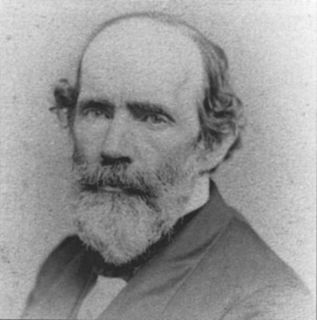
John Cassin was an American ornithologist from Pennsylvania. He worked as curator and Vice President at the Philadelphia Academy of Natural Sciences and focused on the systemic classification of the Academy's extensive collection of birds. He was one of the founders of the Delaware County Institute of Science and published several books describing 194 new species of birds. Five species of North American birds, a cicada and a mineral are named in his honor.
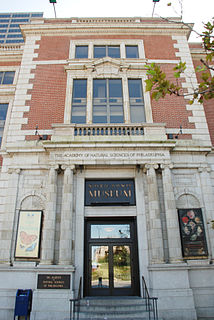
The Academy of Natural Sciences of Drexel University, formerly the Academy of Natural Sciences of Philadelphia, is the oldest natural science research institution and museum in the Americas. It was founded in 1812, by many of the leading naturalists of the young American republic with an expressed mission of "the encouragement and cultivation of the sciences". For over two centuries of continuous operations, the Academy has sponsored expeditions, conducted original environmental and systematics research, and amassed natural history collections containing more than 17 million specimens. The Academy also has a long tradition of public exhibits and educational programs for both schools and the general public.

Titian Ramsay Peale was an American ornithologist, entomologist, photographer, and explorer from Philadelphia, Pennsylvania. He was a scientific illustrator whose paintings and drawings of wildlife known for their beauty and accuracy.

Frank Bennington Gill is an American ornithologist with worldwide research interests and birding experience. He is perhaps best known as the author of the textbook Ornithology, the leading textbook in the field.

The long-wattled umbrellabird is an umbrellabird in the Cotingidae family. Its Spanish names include pájaro bolsón, pájaro toro, dungali, and vaca del monte. The long-wattled umbrellabird is considered rare and it resides in humid to wet premontane and cloud forest. They are often found on the Pacific slopes of southwest Colombia and western Ecuador, but occasionally are found at lower altitudes.
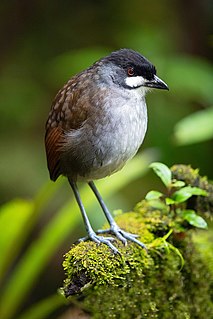
The jocotoco antpitta is an endangered antpitta, a bird from Ecuador and Peru. It was discovered in 1997, and scientifically described in 1999.
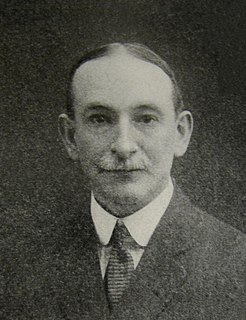
Witmer Stone was an American ornithologist, botanist, and mammalogist, and was considered one of the last of the “great naturalists.” Stone is remembered principally as an ornithologist. He was president of the American Ornithologists’ Union (AOU) 1920–23, and was editor of the AOU's periodical The Auk 1912–1936. He spearheaded the production of the 4th edition of the AOU checklist, published in 1931. He worked for over 50 years in the Ornithology Department at the Academy of Natural Sciences of Philadelphia, eventually serving as Director of the institution. Stone was one of the founding members of the Delaware Valley Ornithological Club (DVOC) in 1890 and was actively involved in the organization for the remainder of his life. Stone was one of only two scientists to serve as president of both the AOU and the American Society of Mammalogists, and he co-authored two popular books about mammals. His outstanding botanical contribution was The Plants of Southern New Jersey, published in 1911. Stone spent many summers at Cape May, New Jersey, summering there annually starting in 1916. He is best remembered for his two-volume classic Bird Studies at Old Cape May, which was published by the DVOC in 1937, two years before his death.

The fawn-breasted tanager is a species of tanager with a blue head and yellow breast. It occurs in the Andes of northwestern Argentina, Bolivia, Colombia, Ecuador, Peru and Venezuela, as well as in the highlands of northeastern Argentina, south Brazil, Paraguay and Uruguay.

The blue-mantled thornbill is a species of hummingbird native to the high-altitude forest and grassland regions of Ecuador, Bolivia, and Peru.

The rufous piha is a species of bird in the family Cotingidae. It is found in Belize, Colombia, Costa Rica, Ecuador, Guatemala, Honduras, Mexico, Nicaragua, and Panama. Its natural habitat is subtropical or tropical moist lowland forests.
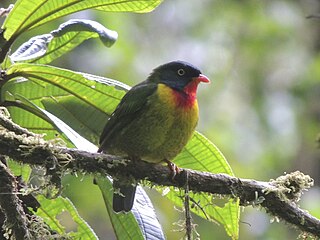
The scarlet-breasted fruiteater is a species of bird in the family Cotingidae. It is found in Bolivia, Ecuador, and Peru where its natural habitat is subtropical and tropical moist montane forests. Two subspecies are recognised though some researchers consider these should be regarded as distinct species. It is a plump green bird with a black head, the males having red throats and the females yellow. It is a relatively common species with a wide range, and the International Union for Conservation of Nature has rated its conservation status as being "least concern".

The plain-tailed wren is a species of songbird in the family Troglodytidae. It has a mostly rufous body with a gray, black, and white striped head. It is found in the Andes of southern Colombia, Ecuador, and northern Peru. Its natural habitat is subtropical or tropical moist montane forests. Plain-tailed wrens are so-called bamboo specialists and live almost exclusively in chusquea bamboo thickets. Like other wrens, its diet consists mainly of insects with some seeds and berries.

Rainforest Trust is a US-based nonprofit environmental organization focused on the purchase and protection of tropical lands to strategically conserve threatened species. Founded in 1988, Rainforest Trust was formerly known as World Parks Endowment. In 2006, then World Parks Endowment affiliated itself with World Land Trust, a UK-based nonprofit environmental organization, and became World Land Trust-US, as both organizations were dedicated to minimizing their costs in order to allow donated funds to flow to habitat conservation projects on the ground. On September 16, 2013, because of diverging modus operandi, and as part of celebrating the organization's 25th anniversary, the World Land Trust-US changed its name to Rainforest Trust.
Fundación de Conservación Jocotoco is an Ecuadorian non-governmental environmental organization. It was established to purchase and protect land important to the conservation of endangered birds in Ecuador.
Paul George William Salaman is an ornithologist and conservationist based the Rainforest Trust, overseeing biodiversity conservation across Latin America.
The Delaware Valley Ornithological Club (DVOC) is the one of the oldest ornithology organizations in the United States. Founded in 1890, the club has held regular meetings at the Academy of Natural Sciences of Philadelphia for over 125 years, and has published the periodical Cassinia since 1901. Membership is open to any dues paying person with an interest in birds. The club organizes birdwatching field trips throughout the Delaware River valley region, including a dedicated year-round trip schedule within the city limits of Philadelphia.
References
- ↑ World Land Trust (6 December 2011). "Prestigious award for Dr Robert Ridgely" . Retrieved 2 October 2012.
- ↑ The Academy of Natural Sciences, Philadelphia - The History of Ornithology at ANSP - Current Situation
- ↑ The Bird that Barks - SciAm June 22, 1998